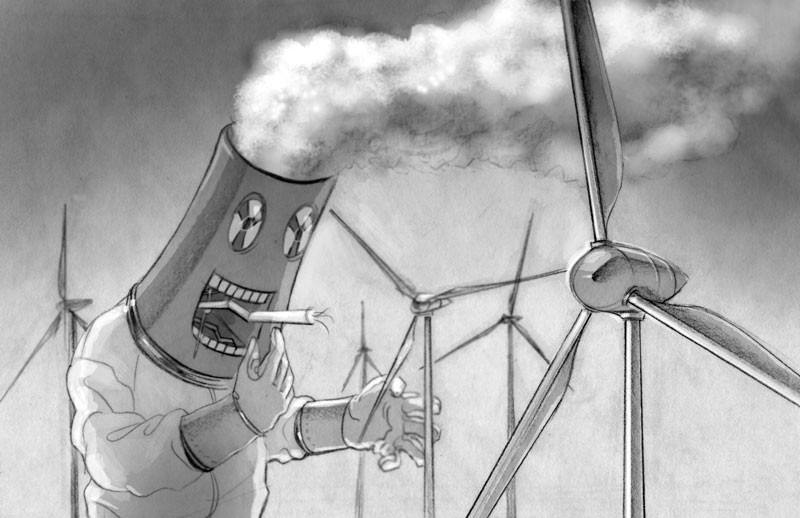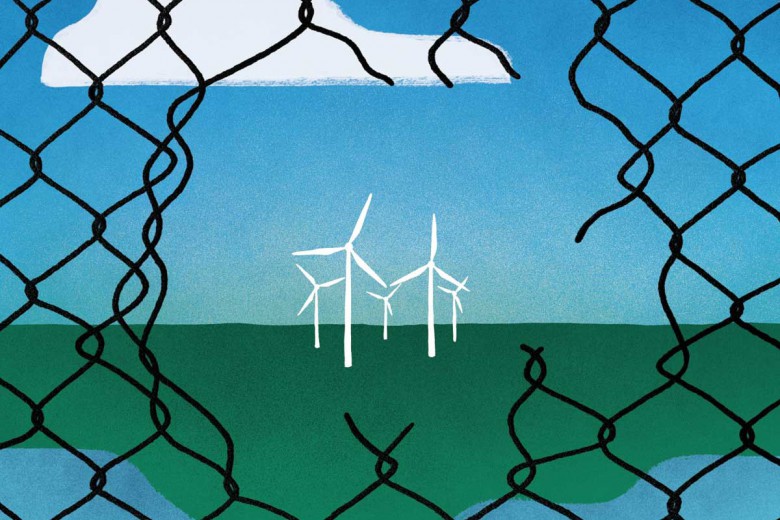
Saskatchewan is quickly joining Alberta in the continental corridor supplying oil and gas to the United States. This deepening integration with the resource-intensive U.S. economy, which leaves a toxic legacy on indigenous and Canadian lands, has its roots in a shift that began in the 1960s. This shift, from an agricultural to a mineral resource economy, was stewarded by all of the province’s governing parties. But when it comes to the nuclear industry, Saskatchewan’s identity as an imperial supply station goes back even further. From the beginnings of uranium mining at Uranium City in the 1950s, to its expansion at Rabbit, Cluff, Key and Cigar Lakes in the 1980s, Saskatchewan has played an integral role in the arming of the planet’s pre-eminent nuclear superpower. The province is deeply complicit in the production of depleted uranium weaponry that has contaminated the theatres of U.S. and NATO warfare since the 1990s, and now faces significant pressure to escalate its commitment to the nuclear industry in the coming years.
Since the Saskatchewan Party defeated the Calvert NDP last year, there has been a flurry of activity laying the groundwork for an expansion of the nuclear fuel chain. The new government is reopening the debate around building a uranium refinery in the province and signalling that nuclear power is on its political agenda. Twenty-five years after the last major industry offensive, the present public relations push is designed to try once more to convince Saskatchewan residents of the desirability and inevitability of nuclear expansion.
In early May 2008, a SaskPower report commissioned under the Calvert NDP but never released, entitled A Preliminary Siting of a Nuclear Power Plant, was leaked to the CBC. Ironically, its final recommendation was that “SaskPower should develop a proactive communications strategy regarding this project in the event that news is leaked to the media.” Lacking any consideration of the potential impact of conservation and cost-effective renewables on future energy demand, this report failed to establish a case for the supposed need for nuclear power. But it did acknowledge the need to locate any plant in a sparsely populated location due to the dangers of catastrophic accidents.
Later that month, the Regina and Saskatoon papers reported the results of a poll commissioned by Cameco’s corporate partner, Bruce Power, which is exploring the options for building nuclear plants in both Alberta and Saskatchewan. The front-page Leader-Post headline, “Saskatchewan Residents Favour Nuclear Options,” failed to highlight the fact that opposition surpassed support (40.5 to 38.1 per cent) when the question was asked about having a nuclear plant on Lake Diefenbaker – the source of 40 per cent of the province’s drinking water and one of the two locations that SaskPower had studied.
This anti-democratic push to manufacture consent continued in June, when, with full backing from the Saskatchewan Party government, Bruce Power announced a feasibility study of nuclear power in Saskatchewan, due before the end of 2008. Another industry-commissioned pro-nuclear poll was widely publicized in August, and in September there was a fanfare of publicity for a Canada West Foundation report entitled Prairie Atoms: The Opportunities and Challenges of Nuclear Power in Alberta and Saskatchewan.
Then, in October, the Sask Party government announced the formation of a Saskatchewan Uranium Development Partnership that would report back by March 2009 on how, in the words of Enterprise and Innovation Minister Lyle Stewart, to “add value to our raw uranium resources.” This new advisory body is to be a veritable who’s who of the Canadian nuclear lobby, consisting of representatives of Cameco, Bruce Power and TransCanada – already partners in the first privatized nuclear facility in Ontario – as well as the French nuclear conglomerate AREVA and token “environmentalist” Patrick Moore, who works for the U.S. Nuclear Energy Institute lobby promoting nuclear power. The tainted process, which allows no public submissions until after the group’s recommendations are delivered, marks an aggressive attempt to sideline public participation in shaping Saskatchewan’s energy future. The gloves are now off when it comes to nuclear politics in Saskatchewan.
The nuclear industry wouldn’t be a player in Canada’s energy market today without the 20-plus billions of dollars of public subsidies the industry has received over the years. The industry therefore needs to convince the public that further public subsidies are deserved in order to meet our future energy needs. This time it is making the environment the centrepiece of its efforts, peddling a bundle of half-truths and outright lies designed to cajole us into believing that a continuation of publicly backed nuclear expansion is compatible with – indeed, contributes to – sound environmental policy. Yet the nuclear fuel chain is intimately interwoven with the greenhouse-gas-producing fossil fuel industry. When Saskatchewan uranium goes south from Port Hope for use in U.S. nuclear power plants, it is first enriched by two dirty coal plants in Kentucky, and the depleted uranium left after enrichment is then added to the Pentagon’s stockpile. As the grade of uranium-bearing ore depletes, even more fossil fuels will be required for the hard-rock mining and milling. Furthermore, the promotion of nuclear power to facilitate the extraction of heavy oil from the tar sands shows how intimately connected these two toxic, non-renewable industries are.
The good news, which the nuclear industry suppresses, is that non-nuclear energy options reduce greenhouse gases more quickly and more cheaply. The work of Amory Lovins at the Rocky Mountain Institute shows that using waste heat to cogenerate electricity, while moving quickly to boost energy from renewables, provides far more bang for one’s buck without leaving a radioactive, toxic legacy for future generations. Already, electricity generation from renewable sources has surpassed the heavily subsidized nuclear capacity worldwide, and the gap will continue to widen. The UN’s Intergovernmental Panel on Climate Change has projected a doubling of renewable-generated electricity (from 18 to 35 per cent) by 2030, while nuclear capacity will remain flat at 16 to 18 per cent. In 2007, China, Spain and the U.S. each added more power-generating capacity through wind power than the entire nuclear industry added worldwide.
So, how has the big lie that nuclear is cheap, peaceful, safe and clean got such traction in the public’s mind? Purely and simply, by repetition of advertising slogans that appeal to simple-minded self-interest. Saskatchewan residents have been living behind this uranium curtain of disinformation for many decades. In Canada’s Deadly Secret, I discuss at length how the industry concluded in the late 1980s that, after decades of uranium mining, Saskatchewan is the most likely province to accept an expansion of the nuclear fuel system. We are the chosen people, the best bet as a place for the highly integrated nuclear industry to relocate and reposition to consolidate its expansion.
Lifting the uranium curtain
If it manages to sufficiently soften public resistance, the barrage of pro-nuclear PR in Saskatchewan could ultimately lead to a uranium refinery, a nuclear power plant and a nuclear waste dump in the province. The constant refrain is that these developments are to be seen as both good and inevitable. But as past attempts to secure public support for a uranium refinery at Warman and a CANDU-3 and SLOWPOKE reactor business in the province in the 1980s demonstrate, public opposition can make a difference. This time, however, the industry is even more desperate and aggressive because the low-cost, low-impact alternatives that will ultimately overtake nuclear are steadily gaining ground. Time is running out.
The experience in other places that did go nuclear is instructive here: France and Japan, the countries that most fully embraced nuclear power, will face a serious domestic energy security crisis as the dangerous reactor waste and decommissioning costs mount. Meanwhile, countries like Germany, which is building up a mixed capacity of renewables (wind already accounts for 30 per cent of electrical capacity in some regions), will make the conversion to sustainable energy much more easily, and will prosper in the process.
So are Saskatchewan residents doomed as gullible hinterland hicks who can be cajoled into becoming North America’s nuclear waste dump? I don’t think so. From 1947 to 1963 Saskatchewan people launched the medicare revolution which eventually swept across Canada. And as with medicare, Saskatchewan’s progressive community has to counter bad ideas with good, presenting an alternative vision that serves the greater public interest and meets our needs by working with, rather than against, natural systems. This is the vision of sustainability. We must bring the dark heritage of nuclear complicity into the light and challenge corporations that play high-stakes games with people’s hopes, fears and offspring.
Debunking Cameco and Bruce Power’s disinformation is critical. To do this, Saskatchewan residents must rebuild respectful relations between First Nations and settler groups. This is vital, as indigenous lands have been targeted for nuclear wastes by Atomic Energy of Canada Limited since the 1980s and the Nuclear Waste Management Organization (NWMO) is now trying to secure a memorandum of understanding with Saskatchewan First Nations to find a “willing community.” Settler groups must come to better understand how honouring the treaties can also work to protect watersheds and land masses that can preserve biodiversity for all of us.
The industry has been promoting “deep geological disposal” of nuclear wastes as the best management strategy, something the 1991-98 Federal Review already concluded that Canadians do not support. An accelerated nuclear phase-out to reduce this waste burden for future generations and on-site nuclear guardianship is the responsible and moral thing to do.
NWMO admits that nuclear wastes remain very dangerous for thousands of years – with a half-life of 25,000 years, plutonium-239 will be poisonous for 500,000 years or 15,000 generations. But it ignores other toxic by-products of the nuclear fuel chain. Radon gas, the second greatest worldwide cause of lung cancer after smoking, is endlessly released from uranium tailings, and has already contaminated many watersheds and aquifers. A study in India shows that indigenous villagers near uranium mines have a cluster of deadly diseases and shortened life expectancy. Refining and conversion processes spread contamination – for instance, Cameco’s Port Hope plant has been shut down since June 2007 due to the discovery it was leaching uranium and toxic chemicals into Lake Ontario. Nuclear plants, erroneously promoted as “clean,” emit radioactive by-products from the fission process that are now linked to higher fatal childhood leukemia in a cluster of European studies. Though nuclear power is promoted as “the peaceful atom,” catastrophic nuclear accidents have and will continue to release radiation equal to nuclear weapons across continents and oceans. The slaughter of thousands of caribou on indigenous lands in Northern Europe due to ingestion of radioactive cesium-137 from Chernobyl stands as a warning to us all.
Saskatchewan is the only region without nuclear plants that is being targeted by the NWMO for nuclear wastes. Northern Ontario has not been receptive to AECL’s nuclear disposal plan, and Manitoba has not only banned nuclear wastes but may ban their transportation. This October, Quebec banned the import of any nuclear wastes or irradiated nuclear fuel from outside the province. The industry’s hope is that Saskatchewan residents have been sufficiently propagandized over a half-century of uranium mining in the province to accept Ontario’s wastes.
Backroom discussions between the Bush and Harper governments have already laid the groundwork for an agreement whereby uranium exporters will have to take back nuclear wastes. The long-term plan, something stressed in the recent Canada West Foundation promotional report, is to move into reprocessing of nuclear wastes as the supply of uranium (a non-renewable resource) steadily dwindles. (This fundamentally flawed report doesn’t even mention the scientific groups that oppose reprocessing because it increases risks of proliferation and nuclear waste storage.) The nuclear plants proposed for Peace River, Alberta, and/or Lake Diefenbaker, Saskatchewan, would help bolster the rationale for a regional nuclear waste site. The Harper government has already given AECL yet another multi-million dollar handout to redesign CANDU so that it can use nuclear wastes from the U.S. light water reactors as reactor fuel.
In the late 1970s Saskatchewan First Nations were not consulted about uranium mine expansion in their territories. Their collective call for a moratorium was dismissed and they were confronted with “take it or get nothing.” Already facing the legacy of dangerous tailings, they are now being asked to take back the even more long-lived, toxic nuclear wastes from faraway nuclear plants. This would involve shipments of highly radioactive spent fuel rods across Canada and Saskatchewan at a rate of two to three per day for 10 years, just to catch up to the wastes that had accumulated prior to 1991. It would involve a perpetual stream of poisons in our midst.
Only a resurgence of grassroots democracy can turn this process around. There are already signs that new networks (indigenous, religious, environmental, labour, green) are beginning to transform widespread powerlessness and despair into a coalition committed to the deep changes needed to protect Mother Earth. This will be part of the larger struggle to keep this region from becoming the fuel tank and toxic waste dump of the U.S. empire. Sustainability, peace and sovereignty are now joined at the hip. Those of us living at the source must become more aware of our unique historical role and work to insert this matter into the mainstream of Saskatchewan politics and culture.
Activist and educator Jim Harding is a retired professor of environmental and justice studies and author of Canada’s Deadly Secret: Saskatchewan Uranium and the Global Nuclear System. He is currently planning regional Saskatchewan speaking tours in concert with the Coalition for a Clean Green Saskatchewan. If interested in sponsoring a local meeting, please contact cleangreensask AT yahoo DOT ca.


_780_520_90_s_c1_c_c.jpg)


